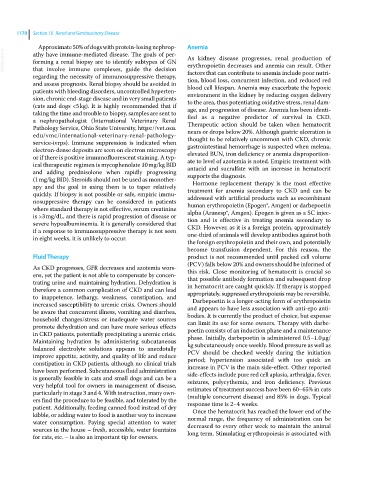Page 1232 - Clinical Small Animal Internal Medicine
P. 1232
1170 Section 10 Renal and Genitourinary Disease
Approximate 50% of dogs with protein‐losing nephrop- Anemia
VetBooks.ir athy have immune‐mediated disease. The goals of per- As kidney disease progresses, renal production of
forming a renal biopsy are to identify subtypes of GN
erythropoietin decreases and anemia can result. Other
that involve immune complexes, guide the decision
regarding the necessity of immunosuppressive therapy, factors that can contribute to anemia include poor nutri-
tion, blood loss, concurrent infection, and reduced red
and assess prognosis. Renal biopsy should be avoided in blood cell lifespan. Anemia may exacerbate the hypoxic
patients with bleeding disorders, uncontrolled hyperten- environment in the kidney by reducing oxygen delivery
sion, chronic end‐stage disease and in very small patients to the area, thus potentiating oxidative stress, renal dam-
(cats and dogs <5 kg). It is highly recommended that if age, and progression of disease. Anemia has been identi-
taking the time and trouble to biopsy, samples are sent to fied as a negative predictor of survival in CKD.
a nephropathologist (International Veterinary Renal Therapeutic action should be taken when hematocrit
Pathology Service, Ohio State University, https://vet.osu. nears or drops below 20%. Although gastric ulceration is
edu/vmc/international‐veterinary‐renal‐pathology‐ thought to be relatively uncommon with CKD, chronic
service‐ivrps). Immune suppression is indicated when gastrointestinal hemorrhage is suspected when melena,
electron‐dense deposits are seen on electron microscopy elevated BUN, iron deficiency or anemia disproportion-
or if there is positive immunofluorescent staining. A typ- ate to level of azotemia is noted. Empiric treatment with
ical therapeutic regimen is mycophenolate 10 mg/kg BID antacid and sucralfate with an increase in hematocrit
and adding prednisolone when rapidly progressing supports the diagnosis.
(1 mg/kg BID). Steroids should not be used as monother- Hormone replacement therapy is the most effective
apy and the goal in using them is to taper relatively treatment for anemia secondary to CKD and can be
quickly. If biopsy is not possible or safe, empiric immu- addressed with artificial products such as recombinant
nosuppressive therapy can be considered in patients human erythropoietin (Epogen®, Amgen) or darbepoetin
where standard therapy is not effective, serum creatinine alpha (Aranesp®, Amgen). Epogen is given as a SC injec-
is >3 mg/dL, and there is rapid progression of disease or tion and is effective in treating anemia secondary to
severe hypoalbuminemia. It is generally considered that CKD. However, as it is a foreign protein, approximately
if a response to immunosuppressive therapy is not seen one‐third of animals will develop antibodies against both
in eight weeks, it is unlikely to occur.
the foreign erythropoietin and their own, and potentially
become transfusion dependent. For this reason, the
Fluid Therapy product is not recommended until packed cell volume
(PCV) falls below 20% and owners should be informed of
As CKD progresses, GFR decreases and azotemia wors- this risk. Close monitoring of hematocrit is crucial so
ens, yet the patient is not able to compensate by concen- that possible antibody formation and subsequent drop
trating urine and maintaining hydration. Dehydration is in hematocrit are caught quickly. If therapy is stopped
therefore a common complication of CKD and can lead appropriately, suppressed erythropoiesis may be reversible.
to inappetence, lethargy, weakness, constipation, and Darbepoetin is a longer‐acting form of erythropoietin
increased susceptibility to uremic crisis. Owners should and appears to have less association with anti‐epo anti-
be aware that concurrent illness, vomiting and diarrhea, bodies. It is currently the product of choice, but expense
household changes/stress or inadequate water sources can limit its use for some owners. Therapy with darbe-
promote dehydration and can have more serious effects poetin consists of an induction phase and a maintenance
in CKD patients, potentially precipitating a uremic crisis. phase. Initially, darbepoetin is administered 0.5–1.0 μg/
Maintaining hydration by administering subcutaneous kg subcutaneously once weekly. Blood pressure as well as
balanced electrolyte solutions appears to anecdotally PCV should be checked weekly during the initiation
improve appetite, activity, and quality of life and reduce period; hypertension associated with too quick an
constipation in CKD patients, although no clinical trials increase in PCV is the main side‐effect. Other reported
have been performed. Subcutaneous fluid administration side‐effects include pure red cell aplasia, arthralgia, fever,
is generally feasible in cats and small dogs and can be a seizures, polycythemia, and iron deficiency. Previous
very helpful tool for owners in management of disease, estimates of treatment success have been 60–65% in cats
particularly in stage 3 and 4. With instruction, many own- (multiple concurrent disease) and 85% in dogs. Typical
ers find the procedure to be feasible, and tolerated by the response time is 2–4 weeks.
patient. Additionally, feeding canned food instead of dry Once the hematocrit has reached the lower end of the
kibble, or adding water to food is another way to increase normal range, the frequency of administration can be
water consumption. Paying special attention to water decreased to every other week to maintain the animal
sources in the house – fresh, accessible, water fountains long term. Stimulating erythropoiesis is associated with
for cats, etc. – is also an important tip for owners.

